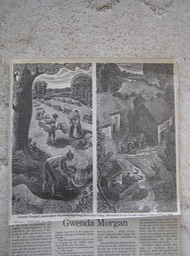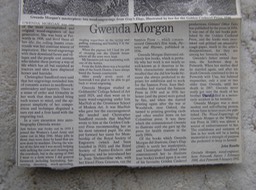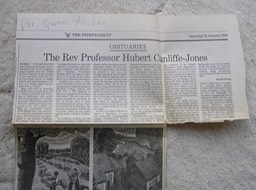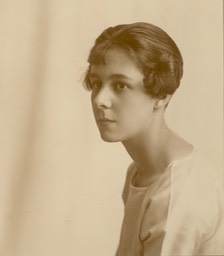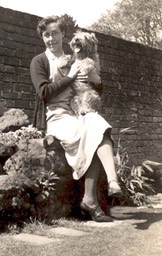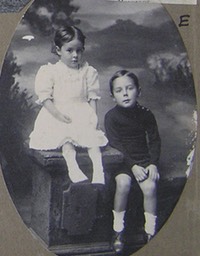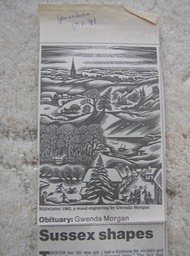Please refer to the text below each graphic.
Online information about Gwenda is available at: (click here).
Here is some of that information preserved from 04.04.2016:
Gwenda Morgan
From Wikipedia, the free encyclopedia
Gwenda Morgan
Born
1st February 1908
Petworth, West Sussex, England
Died
1991
Petworth, West Sussex
Nationality
British
Education
Goldsmiths' College of Art
Grosvenor School of Modern Art
Known for
Gwenda Morgan (1 February 1908 – 1991) was a British wood engraver. She lived in town of Petworth, West Sussex.
Early life[edit]
Morgan was born in Petworth, her father having moved there to work at the ironmongers Austens, of which he later became the proprietor. He was the son of a Welsh-born military farrier.
Following school in Petworth[1] and at Brighton and Hove High School, Morgan studied at Goldsmiths' College of Art in London, from 1926.[2] From 1930 she attended the Grosvenor School of Modern Art in Pimlico where she was taught and strongly influenced by the principal, Iain Macnab.[3]
The Grosvenor School was a progressive art school, and the championing of wood engraving and linocuts fitted with its democratic approach to the arts.[4]
Work[edit]
Morgan was commissioned to illustrate a number of books published by private presses. For the Samson Press she produced the frontispiece for Duke Hamilton's Wager in 1934[5] and Pictures and Rhymes in 1936.[6] She illustrated four books for the Golden Cockerel Press, including Gray's Elegy Written in a Country Churchyard (1946) and Grimms' Other Tales (1956).
Much of her work drew upon the landscape and buildings around Petworth and the neighbouring South Downs. Her work was inspired by that of Macnab, Percy Douglas Bliss and the Sussex-bred Eric Ravilious.[3]
Throughout the Second World War she worked as a Land Girl just outside Petworth. Her record of those years was published by the Whittington Press in 2002 as The Diary of a Land Girl, 1939-1945.
She was a Fellow of the Royal Society of Painter-Etchers & Engravers, an Honorary Member of the Society of Wood Engravers, and a Member of the National Society of Painters, Sculptors and Engravers, and she showed work at their annual exhibitions. She also exhibited at the Royal Academy and at the Redfern Gallery.[7]
Her prints are held in the collections of the Victoria and Albert Museum and the British Museum in London, the Ashmolean Museum in Oxford, and the Fitzwilliam Museum in Cambridge, among others.
In 2015 an exhibition, "A Study in Contrast: Sybil Andrews and Gwenda Morgan", was held at the Art Gallery of Greater Victoria in Victoria, Canada, comparing and contrasting the fellow Grosvenor School artists.[7]
Some of her prints are on permanent display in the Leconfield Hall, Petworth, to which Morgan gave a substantial bequest on her death. Original wood engravings by Morgan are being sold in aid of the Leconfield Hall by the Kevis House Gallery in Petworth.
References[edit]
- Jump up ^ Peter Jerrome, Introduction to The Diary of a Land Girl, 1939-1945, Whittington Press, 2002.
- Jump up ^ A History of British Wood Engraving. Albert Garrett. 1978. Page 389.
- ^ Jump up to: a b Christopher Sandford, 'Gwenda Morgan: an Engraver of the Countryside.' Studio International, 1950. Volume 140. Page 16.
- Jump up ^ Jeanne Cannizzo, A Study in Contrast: Sybil Andrews and Gwenda Morgan. Art Gallery of Greater Victoria, Canada. 2015.
- Jump up ^ Catherine Neil, Gwenda Morgan (ill.) (1934). Duke Hamilton's Wager: a Ballad. Warlingham, Surrey: Samson Press.
- Jump up ^ Julian Francis (2013). Image and Word: The Julian Francis Collection of Prints and Illustrated Books (exhibition catalogue). Monnow Valley Arts. Accessed March 2015.
- ^ Jump up to: a b Peter Zimonjic (19 January 2015). Sybil Andrews and Gwenda Morgan: A Tale of Two Artists. NGC Magazine. National Gallery of Canada. Accessed March 2015.

